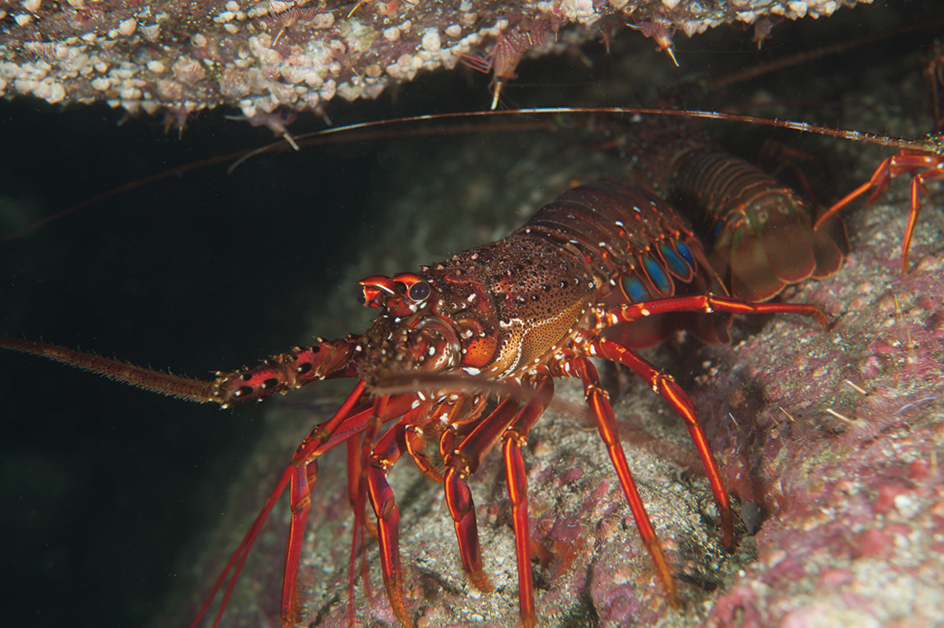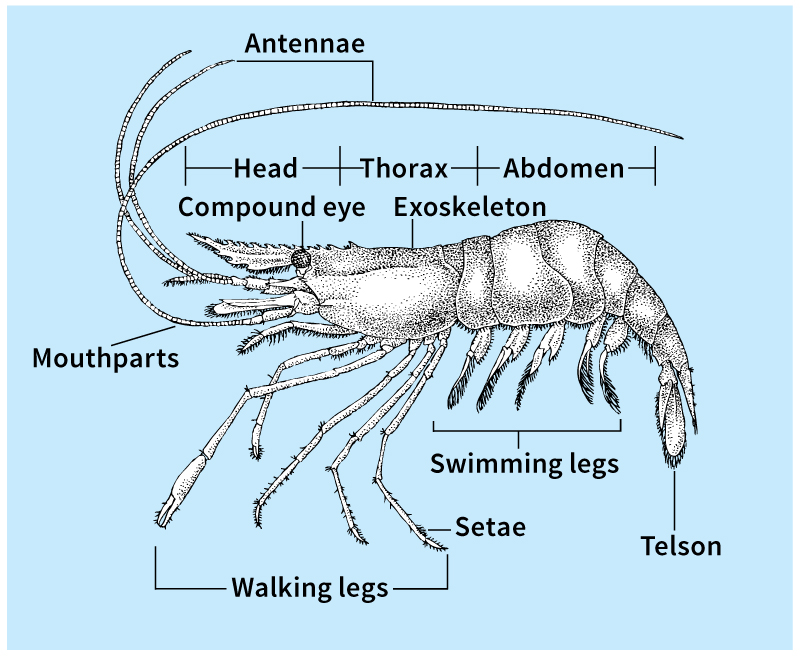Crustacean, << kruhs TAY shuhn, >> is an invertebrate animal with many jointed legs and a hard external shell. A crustacean has no bones. The external shell, called an exoskeleton, covers and protects the body. Crabs, crayfishes, lobsters, and shrimp are crustaceans, as are barnacles, water fleas, and wood lice.

There are tens of thousands of species of crustaceans. The largest species, the giant spider crab of Japan, measures up to 12 feet (3.7 meters) long between its outstretched claws. The smallest crustaceans, such as copepods and water fleas, may be less than 1/24 inch (1 millimeter) long. Most crustaceans live in salt water, but some inhabit fresh water. A few species, including certain crabs and wood lice, live on land.
Crustaceans play a major role in aquatic (water) ecology. In most aquatic environments, small, floating organisms that make up the phytoplankton are the basic food producers (see Plankton). These organisms produce food from light by means of photosynthesis. Many small crustaceans feed on phytoplankton. These crustaceans then are eaten by larger crustaceans, fish, and even baleen whales. Crustaceans thus form an important link between the small food-producing organisms and the larger animals in the aquatic food chain.
People in many parts of the world eat lobsters, shrimp, and other crustaceans. On the other hand, some kinds of crustaceans cause problems for people. For example, certain aquatic wood lice burrow into, and eventually destroy, wooden wharves. Barnacles attach themselves to the hulls of ships and greatly reduce the vessels’ speed. In some tropical regions where farms are near the sea, certain crabs and other crustaceans harm crops by burrowing into and damaging dikes that surround the fields or by eating the young plants.
The body of a crustacean
Outer body.
The body of an adult crustacean typically has three main parts, each of which consists of many segments. These three parts are (1) the head, (2) the thorax, and (3) the abdomen.

The head of a crustacean has two pairs of antennae, a pair of eyes, and three pairs of accessory mouthparts. The eyes may be level with the surface of the exoskeleton or at the ends of stalks. The head also includes the mouth and a pair of jaws.
Each segment of the thorax has a pair of legs. The two pairs of legs closest to the head have pincers (claws), which are used for catching food and bringing it to the mouth, for fighting, and for other activities. Crustaceans use their other legs mainly for walking or swimming. In some crustaceans, gills for breathing develop at the base of the legs.
The abdomen of a crustacean varies greatly in size and appearance, depending on the species. The abdomen of a lobster is large and muscular and extends from the thorax like a tail. The abdomen of a crab, on the other hand, is thin and is folded beneath the thorax. Some species of crustaceans, such as lobsters and shrimp, have leglike appendages on their abdomen. These appendages usually are tiny, and the animal uses them primarily in swimming. A crustacean’s abdomen ends in a flattened, taillike structure called a telson. Some crustaceans snap the telson rapidly to swim backward.
Internal organs.
In large crustaceans, a heart pumps blood throughout the body. Arteries carry blood away from the heart. The blood drains into cavities in the lower parts of the body and then returns to the heart through special openings. Some of the smaller crustaceans, such as certain copepods, have no heart. Their body movements promote circulation of the blood.
A crustacean’s digestive system has three main parts: (1) the foregut, (2) the midgut, and (3) the hindgut. A crustacean has no teeth, and so it cannot chew. Instead, plates and spikes of shell in the foregut grind up food. The food is then directed to the midgut or the hindgut. The midgut produces enzymes and other substances that help digest the food. The hindgut stores undigested materials until they are eliminated from the body through an opening called the anus.
Crustaceans have a simple brain. It is connected to a nerve cord that extends along the underside of the body. Branches from the nerve cord enter each body segment and control various activities.
Most crustaceans breathe through gills. However, many small species have no gills. They breathe through their skin.
Senses.
Most adult crustaceans have a pair of compound eyes. These eyes consist of many separate simple eyes. The entire group of eyes provides the crustacean with a mosaic image and can detect movement (see Compound eye). Adult copepods and a few other species of crustaceans have only simple eyes, which sense light but do not form an image.
Tiny hairlike setae cover various parts of the exoskeleton. Certain of them are sensitive to taste and touch. These sensory setae are concentrated on the antennae, mouthparts, and pincers.
The life of a crustacean
Reproduction.
Among crustaceans, a new individual is created when a sperm of the male fertilizes the egg of a female. The male may deposit sperm on the female’s shell or into sperm receptacles on her abdomen. The sperm then fertilize the eggs as the female lays them. The number of eggs produced at one time varies tremendously among species. The crayfish lays from about 50 to 150 eggs. The Chinese wool-handed crab produces as many as 900,000 eggs at a time. In most species of crustacean, the female carries the eggs on the abdomen and protects them until they hatch.
Growth and development.
Most crustaceans hatch from the egg in an immature form known as a larva. At first, the larva does not look at all like the adult animal. The larva swims weakly in the sea for several weeks. During this time, it gradually changes form, adding new body segments and appendages until it looks like its parents. A few species of crustaceans, including beach hoppers and wood lice, have no larval stage. The young of these species hatch as miniature adults.
A crustacean’s exoskeleton does not expand, and so the growing animal repeatedly sheds its old shell and grows a new, larger one. The shedding process is called molting. Many species of crustaceans continue to molt throughout life, but others stop after reaching maturity. Before molting begins, the crustacean absorbs some of the nutrients from its old shell. It uses these nutrients to form a soft, thin new exoskeleton beneath the old shell. The old exoskeleton then splits, and the animal works its way out of it. The crustacean takes in water and swells to a larger size before the new shell hardens. A crustacean’s muscles are connected to its shell. During molting, muscle attachments to the old shell are broken, and the animal has difficulty moving about. Until the new shell hardens, the animal often hides in a crevice or a small underwater cave.
If certain parts of a crustacean’s body are damaged or lost, they may be repaired or replaced through a process called regeneration. The replacement part may appear during the next molt in a reduced size and then gradually enlarge to full size with successive molts. Some crustaceans, such as crabs and lobsters, can voluntarily detach a limb that has been caught by an enemy.
Food and habits.
A few species of crustaceans live as parasites on other animals. Other species, including crabs, crayfishes, and lobsters, prey on various water creatures or eat the remains of animals and plants. Certain species, such as water fleas and some copepods, as well as many crustacean larvae, drift through the water and feed on floating microorganisms. In turn, these crustaceans are eaten by barnacles, krill, and other crustaceans, and by many kinds of fish. Krill are eaten by baleen whales, fish, and birds. Various other crustaceans become the prey of birds and land mammals.
Crustaceans live in a wide variety of habitats. Some drift continuously in the water as part of the plankton. Others prowl along the shore of a body of water and hide among rocks or weeds. Some find shelter in a sponge or coral, or inside an abandoned shell of a snail. Crabs and some other crustaceans burrow into mud or sand for safety. Barnacles attach themselves to rocks along the seashore as well as to turtles, whales, ships, and wharves. Most land crustaceans live under rocks or in burrows, rotting wood, or other damp places.
